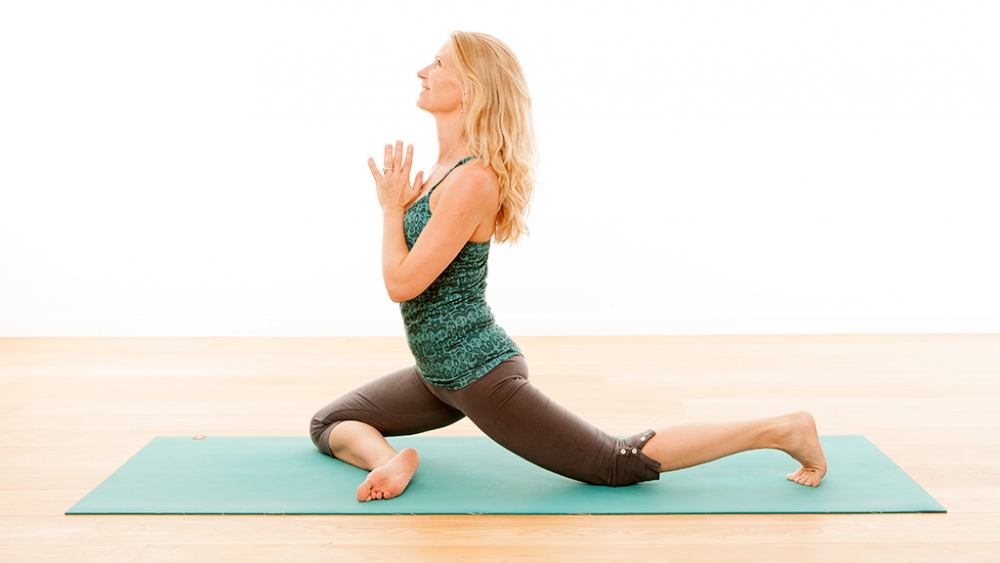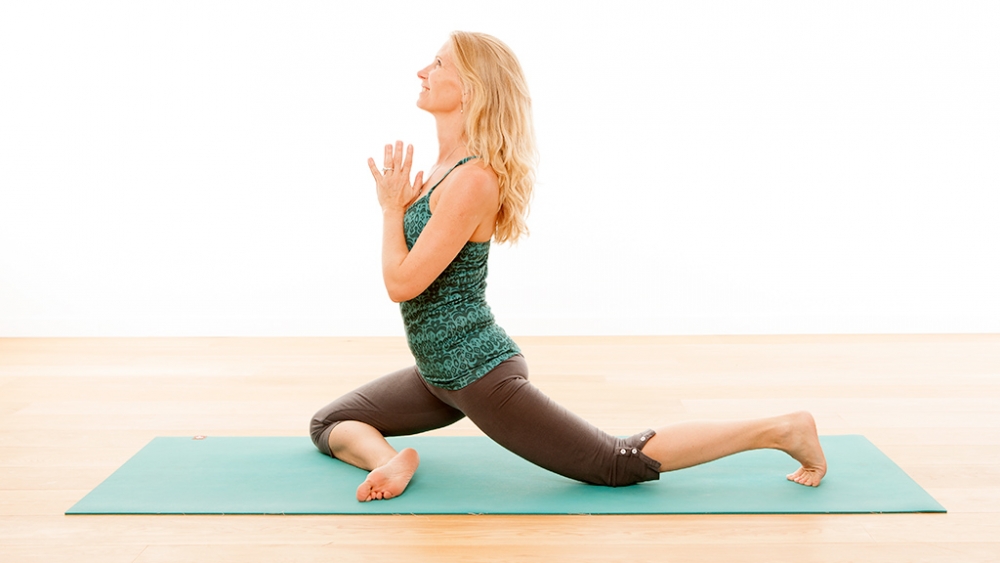One of the many definitions of Vinyasa Yoga is “to place the body in a specific (certain) way with the breath”. Physically we are placing our bones in specific shapes with our skeletal muscles, twisting and turning to massage our internal organs, removing restrictions and adhesions in our connective tissues, and both challenging and nurturing the various systems (cardiovascular, respiratory, lymphatic, immune, endocrine, etc.) of the body. Psychologically we connect to the ebb and flow of not only our own breath and body movements but of everything in the universe (everything arises and everything falls/fades away…even traffic!) Energetically, aligning our bodies in postures allows for the removal of blockages in order for the ease of pranic energy to flow.
Longevity: Practising your yoga safely and intelligently
I try to instil in my students, and my yoga teachers-in-training, to practise with awareness and intention. I believe that by working with the breath and the body in a five-step process you can practise safe yoga and prevent yoga injuries. Ensuring the longevity of your body and mind both on and off the mat.
In my previous articles in this series I covered the first three steps to practising safely and preventing yoga injuries:
Connecting to and moving with the natural rhythms of your breath, Prana and the 5 Vayus,
activating and engaging your bandhas (internal locks) to support lightness of being on this earth,
and proper bone alignment according to posture – placing your bones in the ways they were and bone stacking when possible.
This article will focus on the fourth step: the muscles
By this, I mean activating your muscles with awareness and intention in order to support both static holding postures, and the transition into and out of such held postures.
What are muscles, how do they work and why should we have intimate awareness of them?
There are around 700 muscles in the human body. Three types of muscles are:
- cardiac – involuntary muscles only found in the heart
- smooth – involuntary muscles found in organs and vessels
- and skeletal – bone moving muscles that are both voluntary and involuntary
To optimize the psychological and energetic benefits of our practice we need to create a strong foundation for the body to heal, grow and thrive. This is where skeletal muscle activation plays an important part.
Skeletal muscles are striated; the smallest unit is a fiber, many fibers form a fascicle, many fascicles form a bundle and many bundles form a skeletal muscle. Skeletal muscle fibers operate in one of three states: resting state, contracted state, or stretched state. When contracted, skeletal muscles move our bones where two bones meet (hinge joint, ball-and-socket joint and compressive joint). Knowing exactly how our joints move offers a great basis for a deeper understanding of how our muscles work once activated and engaged as we covered in Bone alignment – preventing yoga injuries
We cannot move our bodies without the use of our skeletal muscles. The only Hatha Yoga posture available to us without our muscles activating is Savasana. For the other 1000 plus postures created, experimented with and practised – whether it be a foot between hands, in an armpit or behind a head – proper activation of our skeletal muscles is needed and necessary.
Muscle contractions and their importance in Vinyasa Flow Yoga
In order to move in and out of poses our skeletal muscles will concentrically and eccentrically contract. Upon landing in a chosen posture it is the isometric contraction that keeps us steady, stable and comfortable (Sthira Sukham Asanam).
Concentric contraction of muscle fibers decreases a joint angle, eccentric contraction is an active yet lessened contraction of muscle fibers during the increase of a joint angle and isometric is the activation of muscles (“wrapping” or “hugging”) with no movement of bones.
Once we become intimate with the way our skeletal muscle fibres activate in order to lift and place our bones, we tend to move on this earth with more ease and grace. It is such a joy to watch an embodied yoga practitioner (or dancer or athlete) place their body with complete awareness and focused intention. And then to watch the same person find the subtleties of their body in stillness… literally watching this can take my breath away.
The constant and continuous scanning of the body in a statically held posture, finding what muscles need to activate (get stronger) and what muscles need to relax (get softer) and making the micro movements necessary to find ease, for me this is the fullest exploration of our body’s ability to isometrically contract.
Agonist and Antagonist muscles: The Brangelinas of the body
Although I’m probably dating myself with this ‘supercouple’ reference (Brad Pitt and Angelina Jolie) I find this visual drives home a very important anatomical point – in the human body there are over 600 skeletal muscles and all of them are in a major relationship with at least one other muscle/muscle group.
When a muscle is an agonist it is the primary mover of the joint. It can only do its job efficiently and effectively if its antagonist “better half” (the opposing muscle, the muscle on the other side of the body) relaxes and releases.
For example, your double headed biceps muscle contracts to flex your elbow (draw your lower arm and upper arms towards each other). Your biceps can only do its agonistic job efficiently and effectively if the three-headed triceps muscle (which is an elbow extensor) relaxes and releases. No matter how strong your biceps are they can not flex the elbow if the triceps are tight. The same thing goes for when the triceps want to straighten your elbow (extension)…the triceps cannot do their job efficiently and effectively if the biceps refuse to relax.
This is why it is so important for yoga teachers to teach well balanced yoga classes. The whole body needs to be stretched and strengthened; we move, shape and bend the body in one direction and then we need to make sure to move, shape and bend it in the complete opposite direction. This translates into anatomical language as flexion and extension in the sagittal plane, abduction and adduction in the coronal plane, and rotation in the transverse plane. In yoga postures this is expressed as POSE and COUNTERPOSE, the simplest example being Cat and Cow Poses.
Harmful habitual patterns and the role yoga plays in undoing them
Habitual patterns are created within our bodies (and our minds!) from what we do for work and play, from physical or psychological trauma, even from the way we habitually position our bodies while we sleep. Now, a shape created in the body once, twice or even 100 times over the span of a lifetime may not necessarily be harmful. It is the hundreds or thousands of repetitive shapes and movements we create in and with our body every day, every week, and every year that become injurious and debilitating.
For example, many of my students work sitting at a desk for 8 or more hours a day or drive for a living and find themselves in forward flexion in the sagittal plane. Often with upper arms (humerus) in internal rotation (rotator cuff muscles subscapularis tight and infraspinatus weak), chest muscles (pectorals) held in a tight contracted (eventually weak) state, upper back muscles (rhomboids and trapezius) stretched and weak, shoulders held in elevated position (upper trapezius and levator scapula tight), abdominals tight and weak, and hip flexors (iliopsoas) super tight encouraging super weak lower back muscles (quadratus lumborum and other extensors).
All of this and more can be seen and felt on the mat in certain poses: weak infraspinatus, quadratus lumborum and abdominal muscles, as well as tight pectorals, upper trapezius and elevator scapula muscles, do not support a successful perfect Chaturanga, tight pectorals, weak upper and lower back muscles, and tight iliopsoas do not support a successful and fulfilling Camel, Bow or Full Wheel, and weak leg muscles (from sitting too much) and tight or weak internal or external hip rotators (from driving leg habits or from crossing legs at desk) will all be felt in standing and balancing poses.
Everything we think, feel and do accumulates in our bodies and, thank goodness, always shows up on the mat to teach us and encourage us to learn, grow and heal.

One of the greatest benefits of the physical discipline of yoga is the undoing of our habitual habits and patterns. One of my favourite things to say to my teachers-in-training is “Our students come to us in fragmented pieces like Humpty Dumpty and it is our job to help them put their pieces back together again”. In a general class, it is important that a yoga teacher offers a well-balanced sequence with both poses and counterposes (think agonist and antagonist) – we don’t know what patterns have been installed in our students throughout their lifetime. For those of us with a daily personal practice the focus can (and will) differ from the general population class structure; we also want a well-balanced practice but because it is a practice just for us we can tweak it in such a way to both support and counteract the daily habitual patterns and shapes we find ourselves in.
The takeaway
It is important for us to listen to our bodies and hear what they need in order to return to a natural state of homeostasis (dynamic equilibrium). On the mat it is imperative to challenge ourselves by holding ourselves in poses that illuminate our weaknesses and we need to explore with breath, movement and patience the areas of our bodies that are tight and tense.
I am a firm believer that we can do all of this more efficiently and effectively if we learn how the human body is designed to move (anatomical knowledge), cultivate an intimate awareness of how our own personal body can or cannot follow suit and gain the knowledge of what we can do on (and off) the mat to aid in our personal healing and empowering process.

